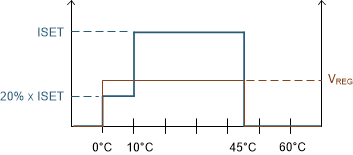ZHCSO24A June 2021 – September 2021 BQ25175
PRODUCTION DATA
- 1 特性
- 2 应用
- 3 说明
- 4 Revision History
- 5 Pin Configuration and Functions
- 6 Specifications
- 7 Detailed Description
- 8 Application and Implementation
- 9 Power Supply Recommendations
- 10Layout
- 11Device and Documentation Support
- 12Mechanical, Packaging, and Orderable Information
7.3.2.4 Battery Cold, Hot Temperature Qualification (TS Pin)
While charging, the device continuously monitors battery temperature by sensing the voltage at the TS pin. A negative temperature coefficient (NTC) thermistor should be connected between the TS and GND pins (recommend: 103AT-2). If temperature sensing is not required in the application, connect a fixed 10-kΩ resistor from TS to GND to allow normal operation. Battery charging is allowed when the TS pin voltage falls between the VCOLD and VHOT thresholds (typically 0°C to 45°C). Charging current is reduced to 20% of the programmed ISET value when VCOLD > TS > VCOOL (typically 0°C to 10°C). The charging profile can be seen in Figure 7-3.
 Figure 7-3 BQ25175 Charging Profile
Figure 7-3 BQ25175 Charging ProfileIf the TS pin indicates battery temperature is outside this range, the device stops charging, enters the STANDBY state, and blinks the STAT pin. Once battery temperature returns to normal conditions, charging resumes automatically.
In addition to battery temperature sensing, the TS pin can be used to disable the charger at any time by pulling TS voltage below VTS_ENZ. The device disables the charger and consumes ISD_IN_TS from the input supply. In order to minimize quiescent current, the TS current source (ITS_BIAS) is duty-cycled, with an on time of tTS_DUTY_ON and an off time of tTS_DUTY_OFF. After the TS pin pulldown is released, the device may take up to tTS_DUTY_OFF to turn the ITS_BIAS back on. After the source is turned on, the TS pin voltage will go above VTS_EN, and re-enable the charger operation. The device treats this TS pin toggle as an input supply toggle, triggering a device power up from input source (see Section 7.3.1).